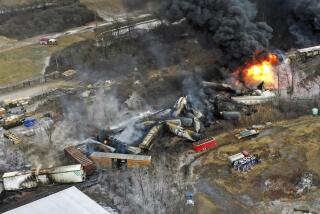Key details in Metrolink crash probe to emerge at public hearing
Federal investigators are summoning witnesses to Washington to testify publicly about how rigorously Metrolink safety procedures were enforced before the September catastrophe that killed 25 people and injured 135.
The two-day hearing next month will examine cellphone use by train crew members, operation of trackside signals that control Metrolink movements and compliance with signal-announcing procedures that are supposed to prevent collisions, officials said.
Potential breakdowns in all those areas have been scrutinized by National Transportation Safety Board investigators trying to reconstruct the causes of the deadliest train crash in modern California history.
“Witnesses will provide vital information on oversight of and compliance with operating rules that were in place the day of the accident,” said NTSB board member Kitty Higgins, who will chair the panel.
The Metrolink engineer sent and received 57 text messages while on duty the day of the crash -- including one just 22 seconds before impact, according to the NTSB’s preliminary findings.
The safety board said the engineer, who died in the crash, ran a red light before slamming head-on into a Union Pacific freight train on a single line of shared track.
The color of that warning light is one of the key details disputed by witnesses. The Times reported late last year that four people -- including the only surviving Metrolink crew member -- said the light was actually green. If so, the engineer would not have been required to stop the commuter train at the signal.
The Times also reported that investigators found that the red light on the critical warning signal was not as bright and clearly visible as green and yellow lights on the same pole.
Metrolink officials have insisted they had a strict ban on cellphone use by crew members at the time of the crash. But the volume of incoming and outgoing text messages from engineer Robert M. Sanchez’s phone in the hours before the crash has called into question how diligently the ban was enforced.
In addition, The Times reported last week that the surviving conductor, Robert Heldenbrand, told NTSB investigators he had complained to a supervisor “a couple of months” before the Chatsworth crash about improper cellphone use by Sanchez while on duty.
Heldenbrand, according to his attorney, said he inquired about the matter again two days before the accident. By Heldenbrand’s account, the supervisor assured the conductor that he would take care of the problem, the attorney said.
The company hired to provide Metrolink engineers and conductors, Veolia Transportation subsidiary Connex Railroad LLC, declined to comment, citing the ongoing probe.
Up to this point, only the investigators directly involved in the multi-agency probe have been privy to many findings. The hearing will offer the public its first look at central details in the inquiry, as Higgins and several NTSB experts question witnesses under oath.
Officials with Metrolink and the other parties will also be allowed to question one another, said Barry M. Sweedler, a former NTSB administrator who has participated in a number of similar inquiry panels.
Witnesses will include representatives from Metrolink, Connex and unions representing engineers and conductors, as well as the Federal Railroad Administration and the state Public Utilities Commission, which regulate Metrolink operations.
More to Read
Sign up for Essential California
The most important California stories and recommendations in your inbox every morning.
You may occasionally receive promotional content from the Los Angeles Times.











